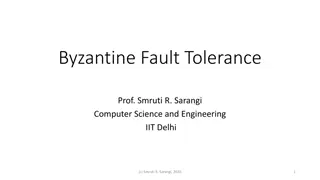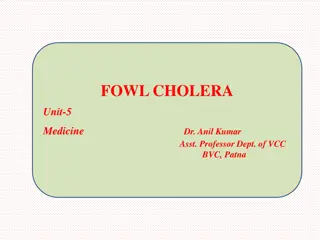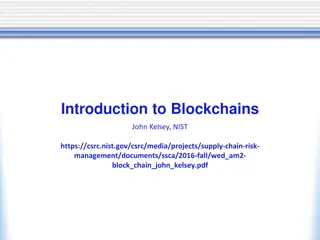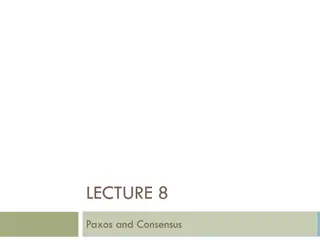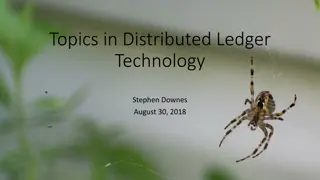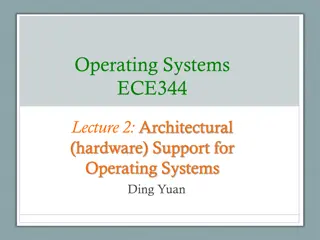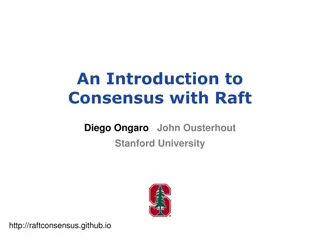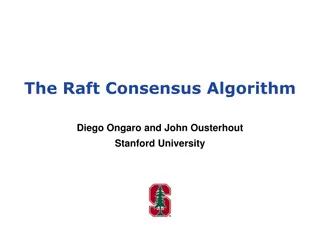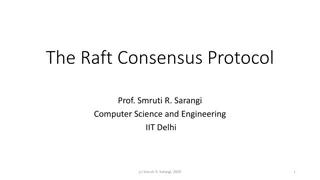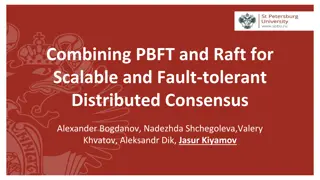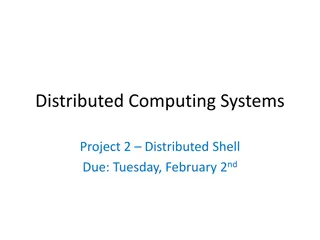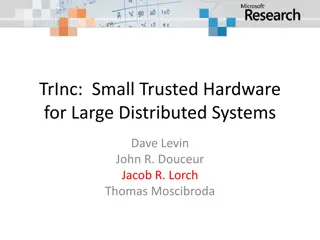Distributed Consensus and Coordination in Hardware Birds of a Feather Session
Specialists in distributed consensus and hardware coordination gathered at Middleware 18 for a session hosted by Zsolt István and Marko Vukoli. The session covered topics such as specialized hardware, programmable switches and NICs, P4 language for expressing forwarding rules, and deployment examples like SmartNICs with Arm and FPGA technologies. The discussion highlighted the flexibility, expressiveness, and resource management benefits of utilizing specialized hardware in distributed systems.
Download Presentation

Please find below an Image/Link to download the presentation.
The content on the website is provided AS IS for your information and personal use only. It may not be sold, licensed, or shared on other websites without obtaining consent from the author. Download presentation by click this link. If you encounter any issues during the download, it is possible that the publisher has removed the file from their server.
E N D
Presentation Transcript
Distributed Consensus and Distributed Consensus and Coordination in Hardware Coordination in Hardware Birds of a feather session at Middleware 18 Hosted by: Zsolt Istv n and Marko Vukoli
Outline Specialized hardware 101 Programmable Switches (P4) Programmable NICs (ARMs) Programmable NICs (FPGAs) RDMA Spectrum of accelerated solutions Examples by scope Examples by location Discussion 2
P4 Language to express forwarding rules on switches (and more) Flexibility: packet-forwarding policies as programs Expressiveness: hardware-independent packet processing algorithms using general-purpose operations and table lookups. Resource mapping and management: compilers manage resource allocation and scheduling. Software engineering: type checking, information hiding, and software reuse. Decoupling hardware and software evolution: architecture independent, allowing separate hardware and software upgrade cycles. Debugging: software models of switch architectures 3
SmartNIC (Arm) Mellanox Bluefield 2x 25/100 Gbps NIC Up to 16 Arm A72 cores Up to 16GB Onboard DRAM Arms can run commodity software Best used to implement something like OpenVSwitch If compute-bound can t keep up with packets! 6
SmartNIC (FPGA) Xilinx Alveo cards 2x 100 Gbps NIC Up to 64GB Onboard DRAM Up to 32MB Onchip BRAM FPGA Can guarantee line-rate performance by design Breaks traditional software tradeoffs 7
Re-programmable Specialized Hardware Field Programmable Gate Array (FPGA) Free choice of architecture Fine-grained pipelining, communication, distributed memory Tradeoff: all code occupies chip space Op 1 Op 2 Op 3 8
Programming FPGAs Challenge: adapting algorithms to the parallelism of the FPGA Synthesized Circuit Placed & Routed Code Coding: Hardware definition languages, high level languages Synthesis: Produce a logic-gate level representation (any FPGA) Place & route: Circuit that gets mapped onto specific FPGA 9
FPGA Benefits and Drawbacks Massive parallelism both pipeline and data-parallel execution Arithmetic operations boosted by DSPs Compute & Data close together thanks to BRAM Can t page code in or out Problem is if algorithm core state doesn t fit in BRAM 10x Less power efficient then ASICs, >10x more power efficient than CPUs 10
RDMA 11
Hardware summary Programmable Switches (P4) Use forwarding tables Guarantee line-rate processing Very high bandwidth Limited state on device, limited complexity code (e.g. branches, loops) Programmable NICs (ARMs) Arbitrary processing Can t guarantee line-rate processing Lower bandwidths Programmable NICs / Switches (FPGAs) Arbitrary processing*, supports complex state on device Can guarantee line-rate processing High bandwidths RDMA NICs No processing, only data manipulation with low latency Low latency buy removing OS overhead 12
Hardware landscape P4 adoption by Chinese companies https://www.sdxcentral.com/articles/news/barefoot-scores-tofino-deals- with-alibaba-baidu-and-tencent/2017/05/ Smart NICs E.g., Mellanox Microsoft Catapult FPGAs in the cloud Amazon, Baidu RDMA support in Azure https://docs.microsoft.com/en-us/azure/virtual-machines/windows/sizes- hpc?toc=%2Fazure%2Fvirtual-machines%2Fwindows%2Ftoc.json 13
Consensus in Hardware Tight integration with network (latency) Low latency decision making (latency) Pipelining (throughput) Follower Ack. Propose Commit Write Leader Propose Commit Ack. Follower Sequencing/reliability in network Ordered, reliable channels 14 Protocol described in: F. P. Junqueira, B. C. Reed, et al. Zab: High-performance broadcast for primary-backup systems. In DSN 11.
Scope of Acceleration (NICs) KVS Replicated operations Full Protocol DARE [1] FARM [2] Common-case APUS [3] Remote log Operations Mellanox Fabric Collective Accelerator (FCA) [1] Poke, Marius, and Torsten Hoefler. "Dare: High-performance state machine replication on rdma networks." Proceedings of the 24th International Symposium on High-Performance Parallel and Distributed Computing. ACM, 2015. [2] Dragojevi , Aleksandar, et al. "FaRM: Fast remote memory." 11th {USENIX} Symposium on Networked Systems Design and Implementation ({NSDI} 14). 2014. [3] Wang, Cheng, et al. "APUS: Fast and scalable Paxos on RDMA." Proceedings of the 2017 Symposium on Cloud Computing. ACM, 2017. 15
Scope of Acceleration Full Protocol Consensus in a Box [1] FPGA NetChain [2] P4 Switch Common-case P4Paxos [3] (NetPaxos [4]) P4 Switch Operations SpecPaxos [5] OpenFlow Switch [1] Istv n, Zsolt, et al. "Consensus in a Box: Inexpensive Coordination in Hardware." NSDI. 2016. [2] Jin, Xin, et al. "NetChain: Scale-Free Sub-RTT Coordination." NSDI 2018 [3] Dang, Huynh Tu, et al. "Paxos made switch-y." ACM SIGCOMM Computer Communication Review 46.2 (2016): 18-24. [4] Dang, Huynh Tu, et al. "Netpaxos: Consensus at network speed." Proceedings of the 1st ACM SIGCOMM SDN. ACM, 2015. [5] Ports, Dan RK, et al. "Designing Distributed Systems Using Approximate Synchrony in Data Center Networks." NSDI. 2015. 16
Consensus in a Box (Caribou) Software clients (>10 machines simulating 1000s of clients) Binary protocol, but can be used as drop-in replacement for SW key-value stores (e.g. Memcached) Client-facing and inter-node traffic: 10Gbps TCP <10 s consensus latency, >1M consensus rounds/s Extension to e.g. SATA, NVMe 10Gbps Ethernet FPGA 8GB DDR3 Memory 17
NetChain Implements KVS in switches Meta-data store, coordination HalfRTT because no need to reach an other end-host s replication (strong consistency) >100Gbps bandwidth Limitations on key/value sizes 18
Paxos Made Switchy Implements the Coordinator and Acceptor roles in P4 Switch Reconfiguration and recovery, as well as management, are external Reduces latency and cost on end-hosts 19
Scope of Acceleration Gains Full Protocol Rely on tight integration of different layers to deliver high throughput/low latency Specializing the processing to the protocol Common-case Benefit from cheaper processing in best case, less egress on end-host Detect when we are not in best case, fall back logic Uses less state on the devices then performing entire protocol Operations Allow the end hosts to push simple tasks of some domain into the network Generate packets, gain from reducing data movement on egress link 21
Integration of Acceleration End hosts (DARE, FARM, Caribou) Easiest integration Most control Split (PaxosMadeSwitchy, ERIS [1]) Integration more complex Less control Switch/Middlebox (NetChain) Packaged as service Independently controlled [1] Li, Jialin, Ellis Michael, and Dan RK Ports. "Eris: Coordination-free consistent transactions using in-network concurrency control." Proceedings of the 26th Symposium on Operating Systems Principles. ACM, 2017. 22
Coordinating control plane ops. A special type of application Update the changes in the SDN controller, detect errors, etc. Low latency operation required Strongly consistent view Molero, Edgar Costa, Stefano Vissicchio, and Laurent Vanbever. "Hardware-Accelerated Network Control Planes." Proceedings of the 17th ACM Workshop on Hot Topics in Networks. ACM, 2018. Schiff, Liron, Stefan Schmid, and Petr Kuznetsov. "In-band synchronization for distributed SDN control planes." ACM SIGCOMM Computer Communication Review 46.1 (2016): 37-43. 23
Application scenarios Replicated KVS Maintain consistent view across replicas Cheaper consensus switch to strong consistency instead of eventual Both throughput and latency is important Could offload at NIC or Switch Part of a larger application OLTP Database transactions lock management Not necessarily KV pairs, could be a tree Many concurrent operations not locking the actual data throughput and latency both important Could be done as offload or as independent service Targeting Distributed Ledgers Each node (many) takes part in consensus Operations on top can be expensive (crypto) unclear how much it is worth optimizing the consensus layer for throughput or latency In non-geo replicated scenarios coordination should become the bottleneck Could be done as offload or as independent service 24
Application spectrum 1ms app time / coordination op Distributed ledgers (core ordering) Machine learning frameworks (parameter server) 100 s app time / coordination op Relational database engine (lock management) Some HPC workloads (MPI barriers) <10 s app time / coordination op NoSQL database engines (distributed transactions, replication) Metadata stores (replication) SDN control plane management (update propagation) 25
Question1: What about Geo-distribution? Intuitively hardware acceleration is not useful in this scenario Or: Can hardware make a difference in keeping algorithms in best case and reduce cost of reconfig/recovery? Or: ? 26
Question1: Geo-Distribution Papers discussed 27
Question2: What about BFT? BFT involves more computation less amenable to low level HW optimization Could we use hardware to keep algorithm in best case? Anything more? Could we use some certification of hardware to relax assumptions? Etc. 28
Question3: TPUT vs. Latency? What ranges are of interest? What combinations are of interest? Is the gain a linear or step function? 29
Question3: TPUT vs Latency + Additional requirement? Most accelerated work 30
Question4: What about programmability? If we had an Paxos ASIC, would that be useful? Are algorithms still changing, or we can use common building blocks? 31
Temperature check Do we feel that there is more to achieve in this space? Which direction should we be looking at? 32
9th Workshop on Systems for 9th Workshop on Systems for Multi Multi- -core and Heterogeneous core and Heterogeneous Architectures (SFMA 2019) Architectures (SFMA 2019) https://sites.google.com/site/sfma2019eurosys/ Researchers from operating systems, language runtime, virtual machine and architecture communities Focuses on system building experiences with the new generations of parallel and heterogeneous hardware No proceedings! Important Dates: Submission: January 17, 23:55 (GMT) Acceptance: February 10th 33



